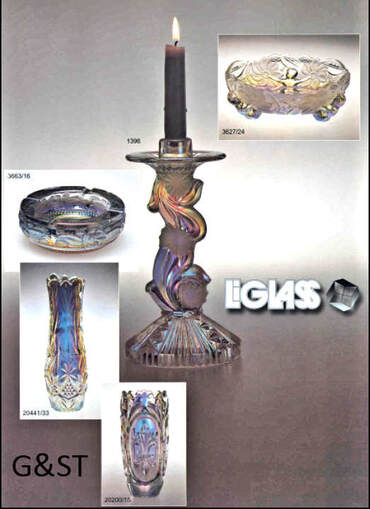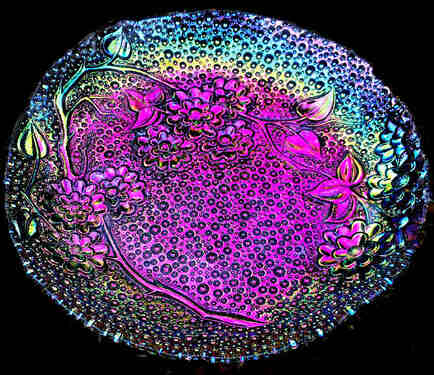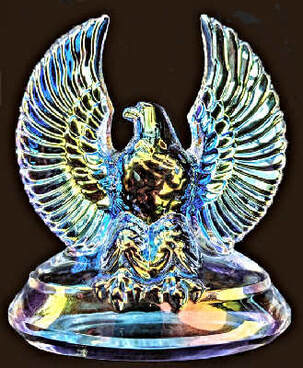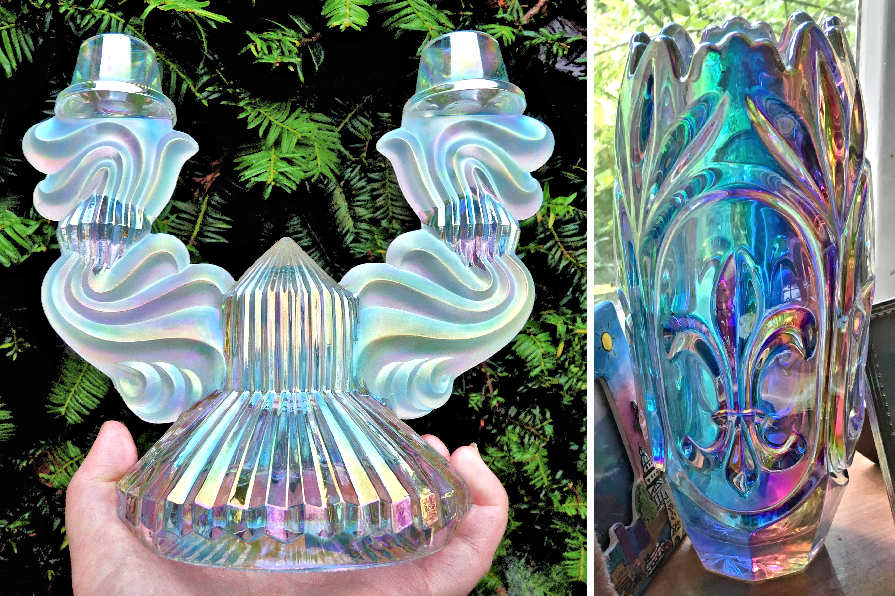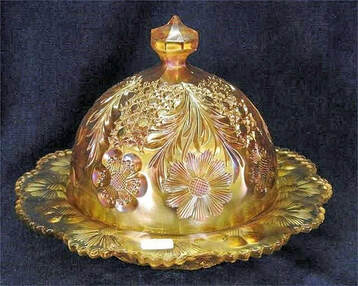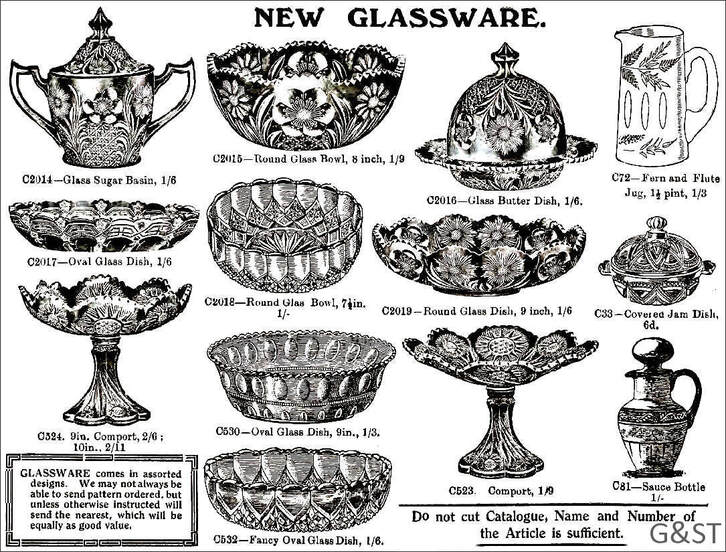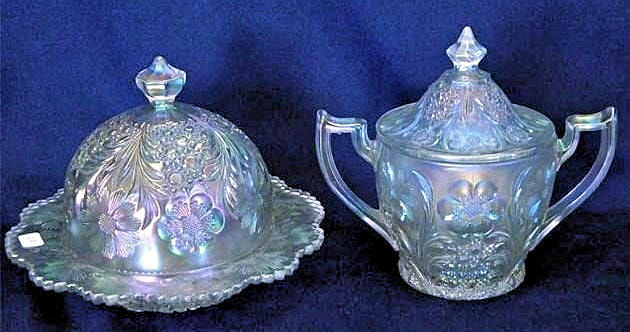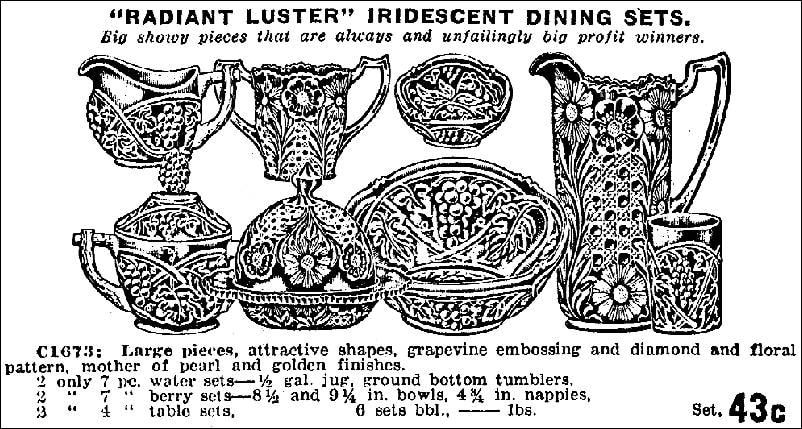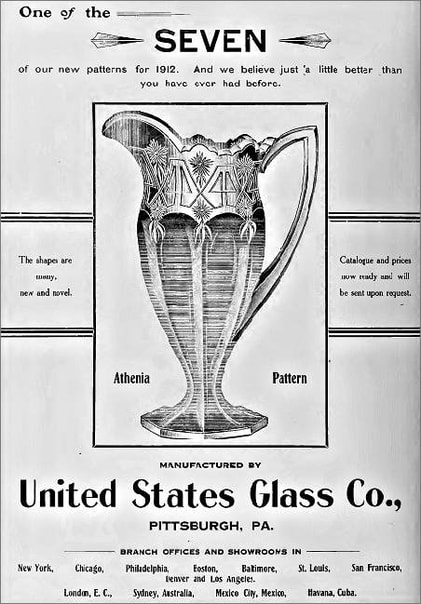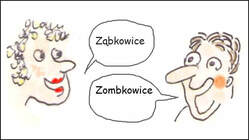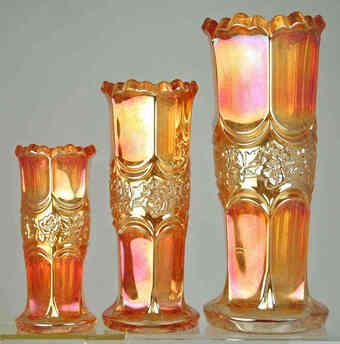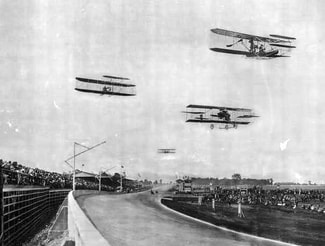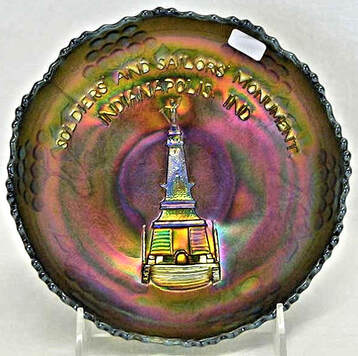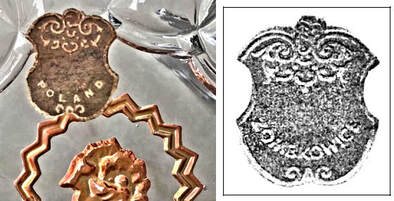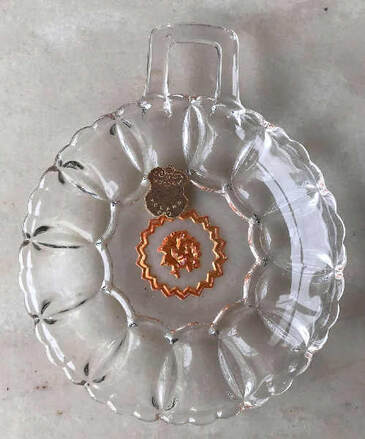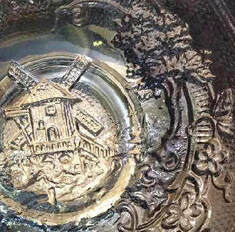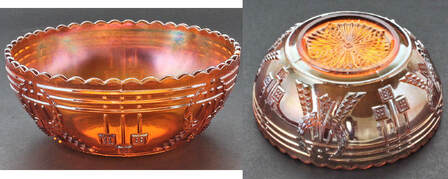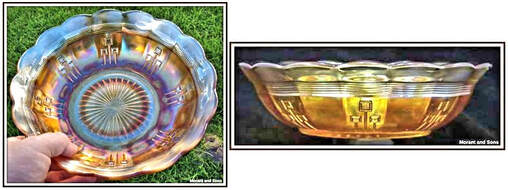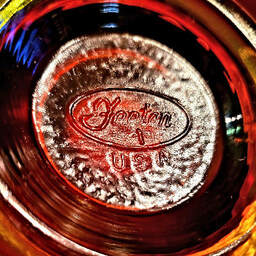NetworK ezine Issue 70. March 2021
Totally Devoted to Carnival Glass
LiGlass – The Revelation
It came as a shock: a small illustration showing the cover of a brochure from a Czech glass company that had gone virtually un-noticed.
When we studied it, many things fell into place and puzzles were almost instantly solved. Here’s that image ... below on the left.
|
Stoelzle Glass Company produced this superb Eagle paperweight, which was vacuum iridised by LiGlass.
It is 5 inches high and 4 inches wide (12.5 x 10 cm). Photo and item identification courtesy Angela Thistlewood. |
The Sublime Deco double stick (left) has a breath-taking, shimmering iridescence.
Our Sklo Union Fleur de Lys vase (right) shimmers with different hues according to the light. This is a Contemporary version of the Classic (old) Inwald Fleur de Lys vase, which was only made in marigold. |
Take a look at the ashtray to the left of the candlestick on the LiGlass cover illustration – it has deeper, purple hues in its iridescence, more reminiscent of the effects created by LGW (Leinauer Glaswaren). The Sklo Union Cherry Blossom plate at the top of this article was almost certainly iridised by LiGlass, using the deeper toned iridescence.
We knew that we had more, vital information at our fingertips, so we began to dig deep into archives and long-lost websites for answers. And we found them!
The full story can be seen in a new major feature. The history, the output and the sad demise of LiGlass is explored, along with a detailed look at the glass (mainly Sklo Union items made in the Czech Republic) that was iridised there, and the likely time period when it was iridised.
It’s a fascinating story, and one that was almost missed … here it is: LiGlass Vacuum Iridising
Here are more links to related information, which is all here, on our website:
Sklo Union iridescent vases
Collectors Facts - Sublime Deco
LGW / Leinauer Glaswaren
Cosmos and Cane.
The ad on the right was in a 1912 Foy & Gibson catalogue in Australia.
The ad on the right was in a 1912 Foy & Gibson catalogue in Australia.
|
We were delighted to find it, as it provided an answer as to why Cosmos and Cane items (made in the USA by the United States Glass conglomerate) are found in Australia. The catalogue clip shows two elements of the table set (butter and covered sugar) and an 8-inch bowl – on the top row. Another bowl (9 inch) is shown on the second row. Above: Cosmos and Cane butter in honey amber.
Below: Cosmos and Cane butter and covered sugar in white. Both pictures courtesy of Seeck Auctions.
|
Above: Foy & Gibson, Australia, 1912.
|
|
Here on the right is another ad - one that we found in the American Crockery and Glass Journal in 1911. It declares that this Athenia pattern was “new … for 1912”. A further snippet of information at the bottom of the ad is the location of the United States Glass Co.’s offices – they had a branch office and showroom in Sydney, Australia. It seems as though the Australian market was particularly important to United States Glass, so much so that they were quickly shipping their very latest patterns and lines to Australia, leading to their early appearance in Foy & Gibson’s 1912 catalogue. Supporting this argument is the fact that U. S. Glass' Cosmos and Cane pieces first appeared in the Butler Brothers wholesale catalogue (in the USA) in April 1912. - as below. Cosmos and Cane selection in Butler Brothers catalogue, April 1912.
|
There are two other U.S. Glass patterns shown in the above Foy & Gibson ad, which cast light on the wider picture. They are Solar, aka Feather Swirl (C524 comport, bottom row, left, and C523 comport, bottom row, second right) and Athenia, aka Paneled 44 (C2017 oval dish, middle row, left).
Both Solar/Feather Swirl and Athenia/Paneled 44 are known in scarce examples of Carnival. Athenia/Paneled 44 - American Crockery and Glass Journal in 1911.
|
Someone was really quick off the mark to get this new United States Glass across to Australia in 1912!
|
Ząbkowice or Zombkowice?
The names may not be familiar to you, but allow us to explain and all will become clear. This renowned glass works in Poland made some superb Carnival Glass, including the wonderful “Golden” patterns such as Golden Cupid and Diana the Huntress, and also the Rose and Drape vases shown here on the right (which is found in three sizes: approx 4.5", 6" and 7.5" high, and known only in marigold so far). The usual spelling of the word in Poland is Ząbkowice - note that the letter "a" has a tail underneath, called an 'ogonek'. It alters the sound of the letter "a" to "om" making the pronunciation much like Zombkowice. Thus, the word Zombkowice was used when it was not easy or possible to use the special letter ą in the word Ząbkowice. It's that simple - it's all down to linguistics and pronunciation.
Both words are pronounced the same - Zomb-coh-veecher. |
Rose and Drape vases.
|
What could possibly be the connection between this famous motor racing circuit, and this very rare "lettered" piece made by Fenton?
Soldiers' and Sailors' Monument Indianapolis
Soldiers' and Sailors' Monument Indianapolis
|
At 284 foot high (just a few feet shorter than the Statue of Liberty), the Indiana State Soldiers' and Sailors' Monument has the distinction of being the first such structure in the USA that was dedicated to the “common” soldier. The actual Indiana State Monument was conceived in 1887. The design came about through an International competition, and it was dedicated on May 15, 1902. The massive structure is topped off with the crowning 30 feet high female figure of “Victory”. Why and when was the Carnival pattern made? Although the Monument was the focus of many public parades and celebrations, none of them fit the time-line of the likely Carnival Glass production by Fenton, which was probably sometime around 1910.
|
The Soldiers' and Sailors' Monument lettered piece is extremely rare. It is known in blue only, in both seven inch plate and bowl shapes (the latter a touch under seven inches). The one above is a blue ice cream shaped bowl - currently the only known example in this shape.
Picture courtesy of Seeck Auctions. |
Our theory is that Fenton made a souvenir for race-goers and tourists, but why so few of them? Perhaps for some reason it didn't appeal, or maybe the design was not actually accepted and only a few were made ... who knows?
Nonetheless, the full story of the Monument is fascinating - read all about it here: The Story Behind the Glass.
Golden Zigzag
|
Christine Batch in Australia sent us photos of this delightful one-handled dish in the Ząbkowice pattern Golden Zigzag (with the Ring-Around pattern around the outside). What was especially delightful about this little beauty is that it has a paper label that reads “POLAND”. The label is the exact shape and style of the Ząbkowice glass work’s label. Shown below, on the left, is a close-up view of the label on the Golden Zigzag (courtesy of Christine Batch), and on the right is a Zombkowice / Ząbkowice standard paper label (courtesy Siegmar Geiselberger). The label on Christine's piece is the exact shape and style of the Ząbkowice glasswork’s label. Further proof that these "Golden" patterns were made in Poland. |
Above: Golden Zigzag. Photo courtesy Christine Batch.
|
Who could resist "FREE Carnival Glass"?
|
This is a small snippet from an ad in September 1965, nearly sixty years ago! Brockway Glass was promoting a big sales push of their Prescription Ware in retail Druggist stores.
The full ad is elsewhere on our website (link below). It didn't actually tell us the name of the company making the glass for them, or the actual patterns that were on offer. Naturally, we didn't want to just guess ... but there were some clues in the ad (such as "Old Windmill"), but there were also some that were misleading (for example, a reference to "matching Candle Holders"). But then we had the answer ... thanks to a wonderful post by Mary Pedano in our Carnival Glass NetworK Group on Facebook. Here is a big clue on the right! To see the full ad and Mary's photos showing the identity of the glassmaker that supplied Brockway, follow this link: Brockway Glass |
|
Lyyra Lookalike
In the previous issue of NetworK we featured this fabulous Carnival Glass Lyyra bowl by Riihimaki, courtesy of Roger Peltonen.
Shortly afterwards we were contacted by Don Ruppel, who pointed out to us the similarity between the early Riihimaki design of Lyyra, and the later Crown Crystal Pin Ups pattern. |
Above: Pin Ups by Crown Crystal, courtesy and copyright Brendan Morant.
Left: Lyyra, courtesy and copyright Roger Peltonen.
|
Although Lyyra has two main repeated motifs – the lyre and the trio of squares, Pin Ups just has the trio of squares. The similarity between the two patterns is clear: Pin Ups was surely inspired by the earlier Riihimaki pattern.
|
And Finally – A Puzzling Fenton Mark Explained
From 2007 onwards, Fenton had two brands - Fenton USA and Fenton International. (The former was all made in the USA, and the latter mostly made in China). Here's what George Fenton wrote in 2009 explaining how this had affected the Fenton marks on their glass: “We add "USA" to each of our moulds as we use them, either below or beside the Fenton logo. A small "1" designates pieces made in 2010 and will continue through 2019". (quote George Fenton).
|
If you have missed any of the previous issues of NetworK and NetworK Specials, they are all here: Back Issues.
Privacy and the use of your information: we only use your name and email address to send you your FREE Carnival Glass NetworK ezine. We will not share your name or email address with anyone else, or use it for any other purpose. You can change your mind about receiving your NetworK ezine at any time by clicking the unsubscribe link at the foot of every issue, or by emailing us at [email protected]
Join us on Facebook
We would love you to come and join in the fun, and we invite you and your friends to join us all on NetworK's fast growing and very active Facebook Group!
We would love you to come and join in the fun, and we invite you and your friends to join us all on NetworK's fast growing and very active Facebook Group!

